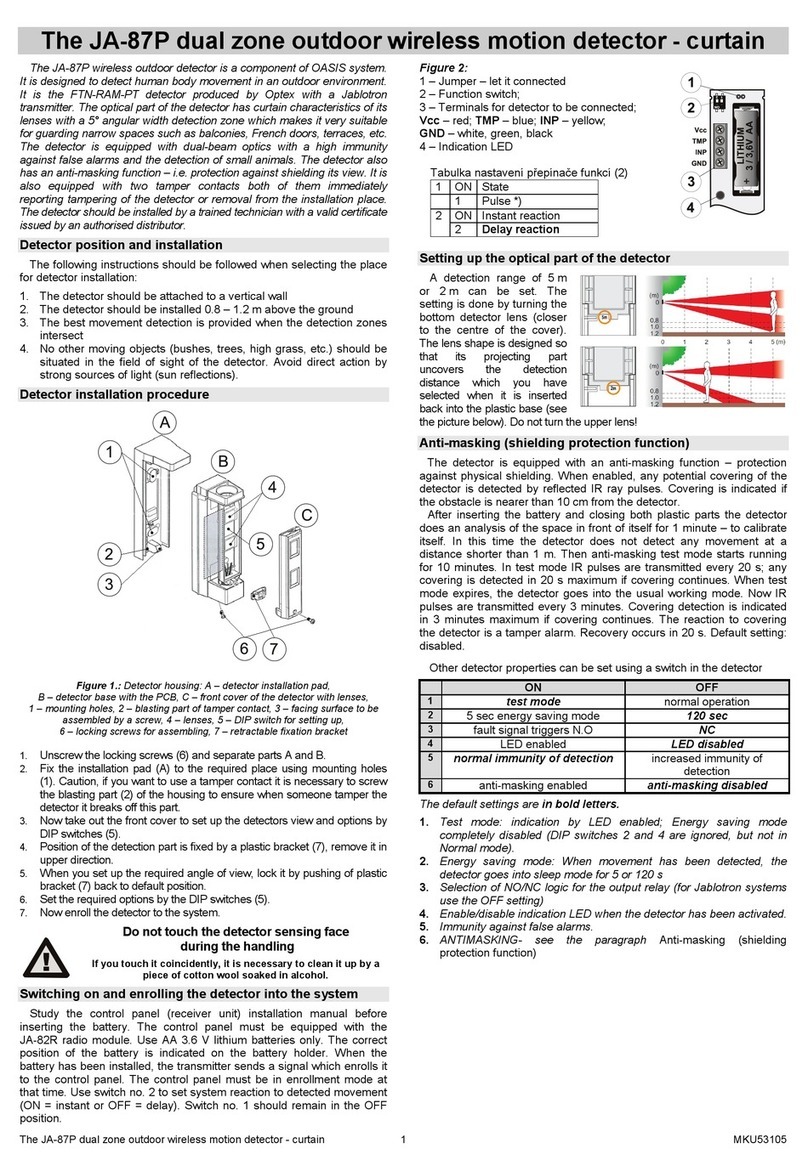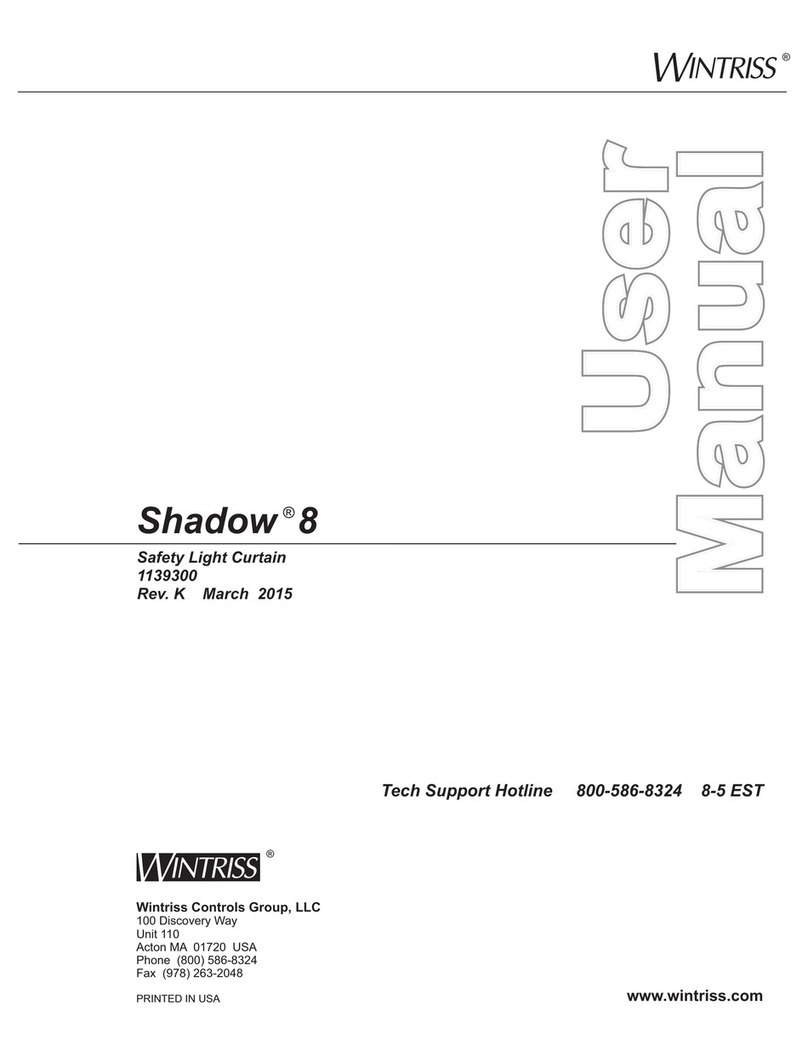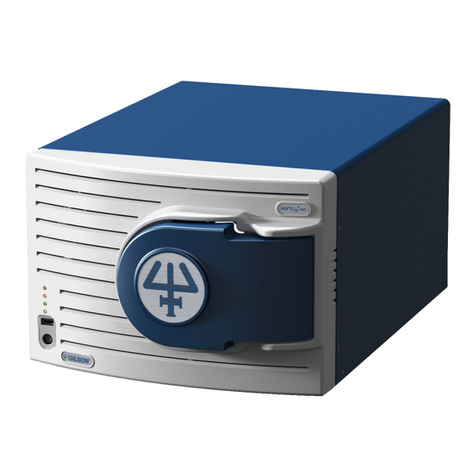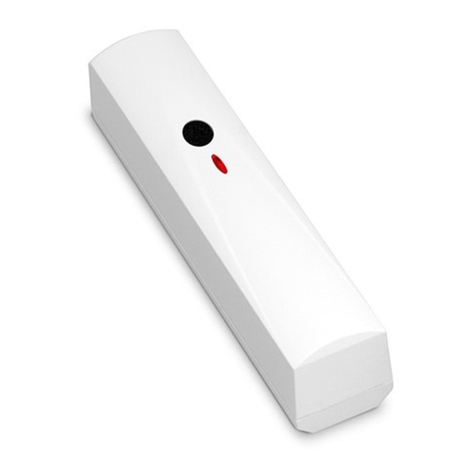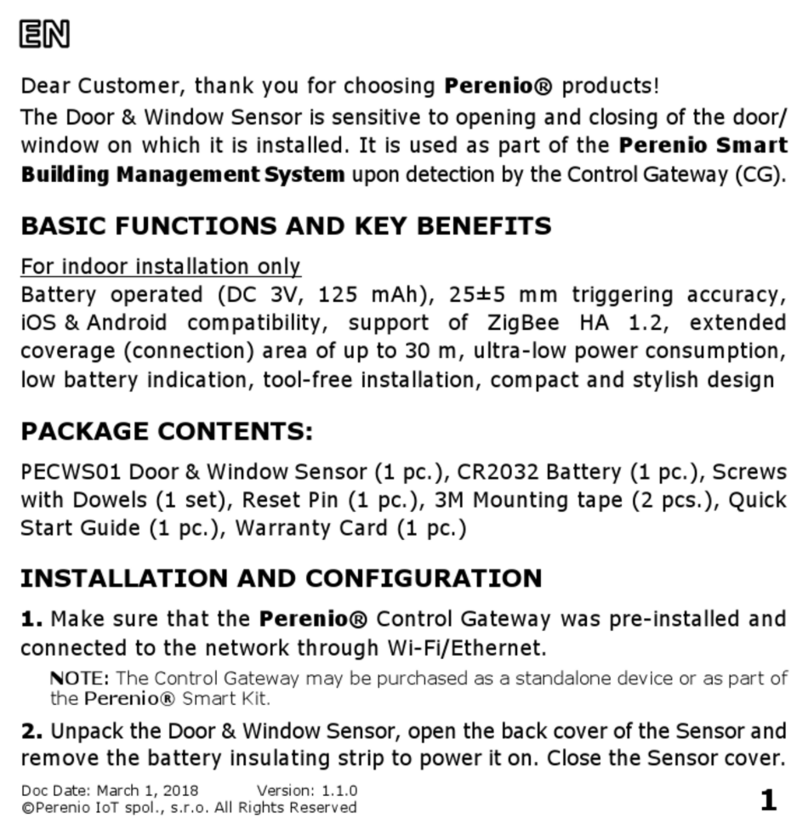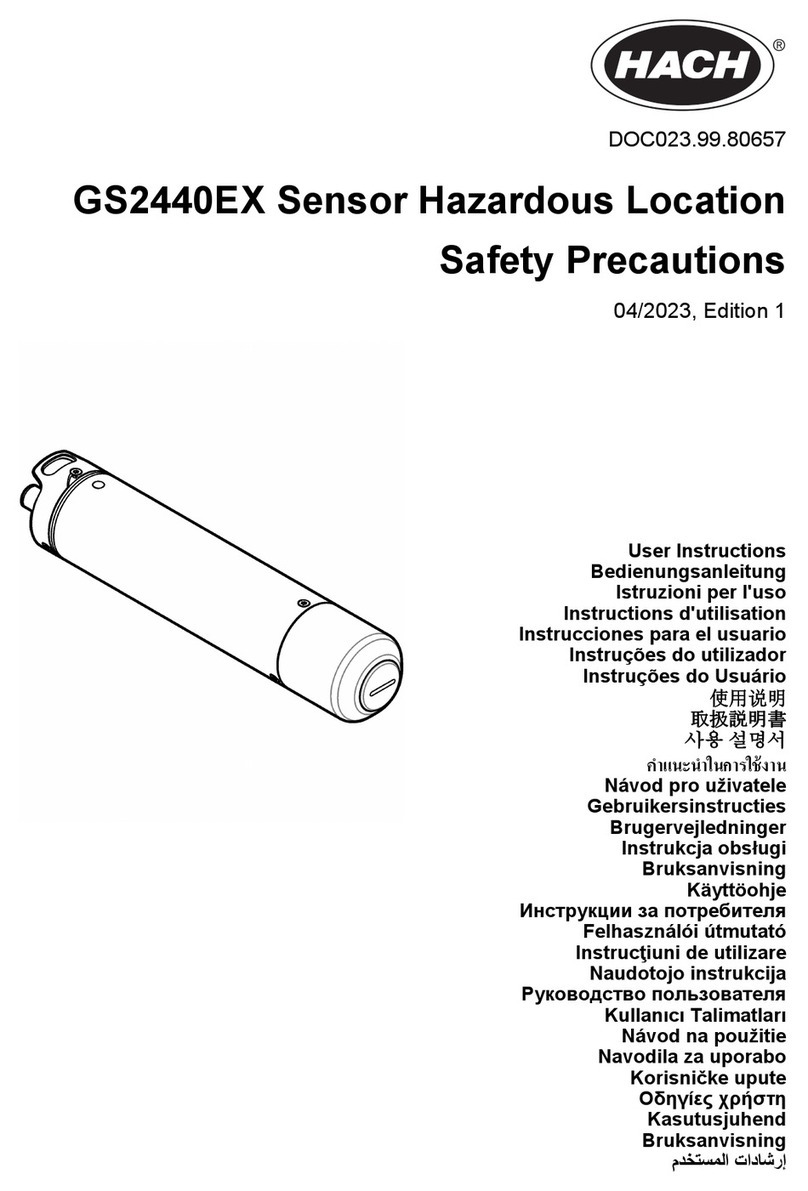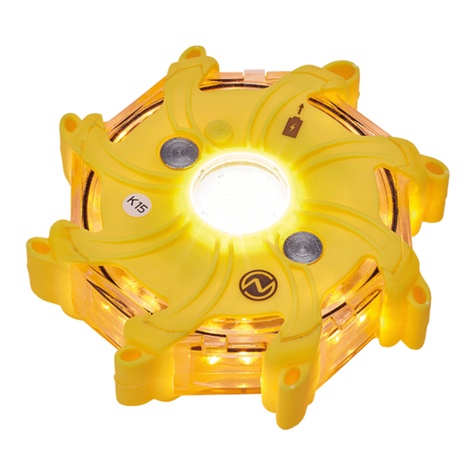SIUI CTS-9006 User manual

CTS-9006 / CTS-9009
Digital Ultrasonic Flaw Detector
Operation Manual
Shantou Institute of Ultrasonic Instruments Co., Ltd.


Shantou Institute of Ultrasonic Instruments Co., Ltd.
III
COMPARISON
This operation manual shall apply to the CTS-9006/ CTS-9009 digital ultrasonic flaw detector. The
differences of the two models on functions and specifications are listed below:
CTS-9006 CTS-9009
Operating Frequency 1~4MHz(-6dB)
0.5~10MHz(-6dB)
1~4MHz(-6dB)
0.5~8MHz(-6dB)
2~15MHz(-6dB)
Rectify
Positive
Negative
Full
Filter
Positive
Negative
Full
Filter
RF
Ethernet Port √
Probe Frequency Measurement √
Cine √
AWS D1.1/D1.5 welding code Optional √
API 5UE
Defect Sizing Quantitative
Criteria
√
Curved Surface Correction √
Crack Height Sizing √
Echo Magnifier within gate √
Amplitude B Scan √
Special Thickness
Measurement Module √
Cine Clips Saved to USB Disk √
Data Memory 300 sets 500 sets
【Note】:The mark √in the table above indicates the corresponding model has such function or
specification.
The compilation of this operation manual is based on the model CTS-9006, and the parameters and
the operation shall apply to the CTS-9006. As the operation of the CTS-9009 is compatible with the
CTS-9006, for additional functions and operation on the CTS-9009, please refer to Appendix D.
Model
Item


Shantou Institute of Ultrasonic Instruments Co., Ltd.
V
DCY2.781.9009/9006SS/B04E
TABLE OF CONTENTS
PREFACE ......................................................................................................................................... IX
OPERATION CAUTIONS AND SAFETY GUIDE.............................................................................. XI
CHAPTER 1 SYSTEM ........................................................................................................................1
1.1 APPLICATION SCOPE ...............................................................................................................1
1.2 APPEARANCE..........................................................................................................................1
1.3 PORT AND SOCKET..................................................................................................................3
1.4 KEY........................................................................................................................................3
1.5 MENU.....................................................................................................................................4
1.6 MEASUREMENT DATA AREA......................................................................................................6
1.7 MEASURE DATA AREA..............................................................................................................7
CHAPTER 2 SYSTEM OPERATION...............................................................................................9
2.1 POWER SUPPLY ......................................................................................................................9
2.2 POWER ON .............................................................................................................................9
2.3 POWER OFF ...........................................................................................................................9
2.4 MAIN MENU SELECTION.........................................................................................................10
2.5 SUBMENU SELECTION ...........................................................................................................10
2.6 TURNING PAGE .....................................................................................................................10
2.7 GENERAL SUBMENU ADJUSTMENT .........................................................................................10
2.8 EXTENDED SUBMENU ............................................................................................................ 11
2.9 SELF-DEFINED FUNCTION KEY ................................................................................................ 11
2.10 FREEZE ................................................................................................................................13
2.11 AUTO GAIN ...........................................................................................................................13
2.12 AUTO CORRECTION...............................................................................................................13
2.13 ANGLE MEASUREMENT..........................................................................................................16
2.14 DAC ....................................................................................................................................17
2.14.1 Making DAC Curves ....................................................................................................17
2.14.2 Deleting DAC Curves...................................................................................................18
2.15 AVG.....................................................................................................................................19
2.15.1 Making AVG Curves.....................................................................................................19
2.15.2 Deleting AVG Curves ...................................................................................................20
2.16 STORE..................................................................................................................................21
2.16.1 Save.............................................................................................................................21
2.16.2 Recall...........................................................................................................................21
2.16.3 Delete ..........................................................................................................................21
2.16.4 Delete All......................................................................................................................21

Shantou Institute of Ultrasonic Instruments Co., Ltd.
VI
2.16.5 Directory.......................................................................................................................22
2.16.6 Preview ........................................................................................................................22
2.16.7 Output ..........................................................................................................................22
2.16.8 Subject .........................................................................................................................22
2.16.9 Import...........................................................................................................................23
2.17 COORDINATE MODE...............................................................................................................24
2.18 PARAMETER OUTPUT.............................................................................................................25
2.19 MEASPT SELECT...................................................................................................................26
2.20 MEASUREMENT SELECT FOR GATE B ......................................................................................27
CHAPTER 3 PROMPTS AND TIPS FOR SYSTEM APPLICATION .............................................29
3.1 GAIN STEP QUICK ADJUSTMENT.............................................................................................29
3.2 QUICK STORE AND RECALL ....................................................................................................29
3.3 TEST RANGE SETUP ..............................................................................................................29
3.4 SYSTEM TEXT PROMPT..........................................................................................................29
3.5 STORE AND RECALL OF SYSTEM STATE AND TESTING PARAMETER ...........................................30
3.6 SYSTEM PARAMETER SETUP SPECIFIC TO TESTING .................................................................30
3.7 USING BATTERY TO INCREASE ANTI-INTERFERENCE ................................................................30
3.8 APPLICATION OF PEAKENVELOP .............................................................................................31
3.9 APPLICATION OF PEAKECHO ..................................................................................................31
3.10 APPLYING PEAKECHO TO MAKE DAC CURVES........................................................................31
3.11 USING DIFFERENT COLORS TO ACHIEVE OPTIMAL VISUAL EFFECT IN APPLICATION....................31
3.12 IMPACT OF GATE STATE ON GATE MEASUREMENT RESULTS .....................................................32
CHAPTER 4 TESTING APPLICATION AND EXAMPLES............................................................33
4.1 TESTING WITH ANORMAL PROBE ...........................................................................................33
4.2 TESTING WITH AN ANGLE PROBE............................................................................................33
4.3 APPLICATION EXAMPLES ........................................................................................................34
4.3.1 Application Example of JB/T 4730-2005 Standard .......................................................34
4.3.2 Application Example of GB 11345-1989.......................................................................36
CHAPTER 5 PERIPHERAL DEVICES, PORTS AND ACCESSORIES ........................................39
5.1 PROBE PORTS ......................................................................................................................39
5.2 USB PORT............................................................................................................................39
5.2.1 Connecting to a USB Disk............................................................................................39
5.2.2 Removing a USB Disk..................................................................................................39
5.2.3 Connecting to a USB Printer ........................................................................................40
5.2.4 Removing a USB Printer ..............................................................................................40
5.2.5 Printing with a USB Printer...........................................................................................40
5.3 BATTERY...............................................................................................................................40
5.3.1 Battery Installation and Removal..................................................................................40
5.3.2 Charging the Battery ....................................................................................................41
5.3.3 Using the Battery..........................................................................................................41
5.3.4 Battery Maintenance ....................................................................................................42
5.4 CHARGER/ADAPTOR..............................................................................................................43

Shantou Institute of Ultrasonic Instruments Co., Ltd.
VII
5.5 BAG .....................................................................................................................................43
CHAPTER 6 TRAINING, SYSTEM MAINTENANCE AND SERVICE ...........................................45
6.1 TRAINING..............................................................................................................................45
6.2 SYSTEM MAINTENANCE .........................................................................................................45
6.3 SERVICE...............................................................................................................................45
APPENDIX A COMMON FAILURES AND TROUBLESHOOTING ............................................47
A.1 THE SYSTEM CANNOT POWER ON ...........................................................................................47
A.2 THE SYSTEM CANNOT POWER OFF..........................................................................................47
A.3 NO “USB DISK CONNECTED”PROMPT WHEN A USB DISK IS CONNECTED ..................................47
A.4 CANNOT PRINT ......................................................................................................................48
A.5 CANNOT CHARGE ..................................................................................................................48
A.6 NO ECHO..............................................................................................................................48
A.7 CANNOT MAKE DAC CURVES .................................................................................................48
A.8 CANNOT MAKE AVG CURVES..................................................................................................49
A.9 INCORRECT DEPTH READING WHEN USING AN ANGLE PROBE ....................................................49
A.10 INCORRECT HORIZONTAL READING WHEN USING AN ANGLE PROBE ............................................49
APPENDIX B SPECIFICATIONS ................................................................................................51
APPENDIX C SUBMENU DEFAULT VALUE AND RANGE OR OPTION ..................................55
APPENDIX D ADDITIONAL DATA ON CTS-9009......................................................................59
D.1 APPEARANCE........................................................................................................................59
D.2 CTS-9009 MENU STRUCTURE...............................................................................................61
D.3 ADDITION FUNCTIONAL OPERATION (BASED ON CTS-9006).....................................................63
D3.1 Radio Frequency Rectify (RF)......................................................................................63
D3.2 Band ............................................................................................................................64
D3.3 Cine .............................................................................................................................64
D3.4 Frequency Measure .....................................................................................................66
D3.5 Gate Magnifier .............................................................................................................66
D3.6 AWS D1.1/D1.5 Welding Level Calculation..................................................................66
D3.7 Crack Height ................................................................................................................67
D3.8 API 5UE Defect Sizing (A Quantitative Method)...........................................................68
D3.9 CSC (Curved Surface Correction)................................................................................69
D3.10 Amplitude B Scan ........................................................................................................69
D3.11 Network Communication..............................................................................................70
D3.12 Thickness Measurement..............................................................................................70
APPENDIX E ABBREVIATION LIST ..........................................................................................75
APPENDIX F DESCRIPTION OF SYMBOL ...............................................................................79
CONTACT INFORMATION ...............................................................................................................81


Shantou Institute of Ultrasonic Instruments Co., Ltd.
IX
Preface
The CTS-9006/ CTS-9009 digital ultrasonic flaw detector is the perfect combination of various
advanced modern technologies such as ultrasonic flaw detection, computer, electronics, mould,
techniques. Therefore we present a series of digital ultrasonic flaw detectors with higher
performance and more powerful functions to the industry.
Main features of the CTS-9006/ CTS-9009 digital ultrasonic flaw detector:
1)Small size —— The dimension of the whole unit is 152mm×240mm×52mm (W×H×D). This is the
smallest size among all flaw detectors with a 5.7-inch monitor.
2)Light weight —— The total weight of the unit (including battery) is 1.15kg only.
3)Low consumption —— Given that the system has small size and light weight, a fully-recharged
battery can support the system to work continuously over 7 hours.
4)High performance ——The main technical specifications, such as detection sensitivity surplus,
vertical linearity, horizontal linearity and dynamic range, are much better than the requirements
of China’s national standard.
5)Rich functions —— The system is featured with USB port, auto gain control, peak memory, DAC,
AVG. Moreover, the CTS-9009 has many additional functions, such as network communication,
probe frequency measure, cine, curved surface correction and AWS code.
6)Easy operation —— The user-friendly system interface is quite intuitive with just a few buttons
for easy definition and simple operation.
This Operation Manual contains the following chapters:
Chapter 1 gives a brief introduction to the system.
Chapter 2 describes system menus and functional operation.
Chapter 3 describes some operation techniques, so as to facilitate the users to operate the system
quickly and conveniently.
Chapter 4 describes the general steps when performing field testing with the system, and gives
some application examples.
Chapter 5 describes how to use peripheral devices, ports and accessories.

Shantou Institute of Ultrasonic Instruments Co., Ltd.
X
Chapter 6 describes operator training and system maintenance.
Appendix A describes how to identify system common failures and troubleshoot the problems.
Appendix B describes system main performance specifications.
Appendix C describes system submenus.
Appendix D describes differences between CTS-9009 and CTS-9006, and their corresponding
operations.
To know system features and operation, as well as how to perform ultrasonic testing with the system,
please read this Operation Manual carefully before using the system.

Shantou Institute of Ultrasonic Instruments Co., Ltd.
XI
Operation Cautions and Safety Guide
1) Please keep this Operation Manual and always operate the system by following the steps
and methods described in the Operation Manual.
2) Before operating the system, the operator shall have received formal training on ultrasonic
testing.
3) Do not try to dismantle and repair the system unless specifically described in the Operation
Manual.
4) The system warranty will be void if the fragile labels on specific positions are damaged.
5) Do not place the system in the place of moisture or near radiator, strong magnetic field or
heat source.
6) When the system is not in use for a long time, it should be powered up at lease once every
month.
7) Avoid collide any hard object against the display screen.
8) Do not use a damaged or worn-out power cable.
9) For cautions on using the battery, please refer to 5.3.4 Battery Maintenance.
10) For cautions on using the charger/adaptor, please refer to 5.4 Charger/Adaptor.


Shantou Institute of Ultrasonic Instruments Co., Ltd.
1
Chapter 1 System
1.1 Application Scope
The CTS-9006 is a lightweight and compact digital ultrasonic flaw detector, especially suitable for:
1)Material testing, flaw positioning and echo evaluation
2)Thickness measurement
3)Testing result storage and recording
4)General ultrasonic testing
1.2 Appearance
Fig. 1-1 System Front View
Main Menu Key
Main Menu Key
Function Key
Power Indicator
Power Key
Direction Key
Confirm Key

Shantou Institute of Ultrasonic Instruments Co., Ltd.
2
Fig. 1-2 System Back View
Fig. 1-3 System Side View
Handle
Battery
Battery securing screw
Probe Socket R
Probe Socket T

Shantou Institute of Ultrasonic Instruments Co., Ltd.
3
Fig. 1-4 System Top View
1.3 Port and Socket
Please refer to Fig. 1-3 and Fig. 1-4.
Table 1-1 Usage of Ports and Sockets
Name Usage
Probe Socket T, R
To connect a probe. T is for transmitting while R is for
receiving.
Buzzer Port The buzzer sound outlet when the alarm sound is enabled.
USB Port To connect a USB disk or a printer.
DC Power In Socket
For main unit power supply when connected to the external
charger/adaptor (CD-92).
Battery Charging In
Socket
For charging battery when connected to the external
charger/adaptor (CD-92).
1.4 Key
Please refer to Fig. 1-1 for key diagram and Table 1-2 for key functions.
DC Power In Socket
Buzzer Port
USB Port
Battery Charge In Socket

Shantou Institute of Ultrasonic Instruments Co., Ltd.
4
Table 1-2 Key Function Description
Key Key Name Function
▲
▲, ►
►, ▼
▼, ◄
◄Direction To select submenu, adjust value and switch item.
F
F1
1
Self-defined function key, which can be defined as
PeakEnv, PeakEcho, ScreenShot or Print function.
F
Fr
re
ee
ez
ze
e
To activate / cancel freeze function.
A
AG
GC
C
Function
To activate / cancel AGC function.
Confirm To execute a function or confirm an item.
B
Ba
as
si
ic
c
To adjust system basic parameters, including Range,
Velocity, Delay, Zero, Reject, Gain, Step, Gate Start,
Gate Width, and Gate Thresh.
D
DA
AC
C
To use DAC main menu.
A
AV
VG
G
To use AVG main menu.
C
Co
or
rr
r
To use auto correction main menu.
S
St
to
or
re
e
To use Store main menu.
C
Co
on
nf
fi
ig
g
Main Menu
To adjust and configure main menu.
Power To turn on/off the system.
1.5 Menu
Please refer to Table 1-3 for the menu structure.

Shantou Institute of Ultrasonic Instruments Co., Ltd.
5
Table 1-3 Menu Structure
Main Menu Submenu Submenu Main Menu Submenu Submenu
Gain GAThresh DAC_Op LineType
Step GALogic GAStart
Standard
SPath ^ GBStart Gain
Vel ^ GBWidth SPath ^
Dly ^ GBThresh DAC_L1
Zero ^ GBLogic DAC_L2
Rej GBMeasure DAC_L3
GAStart ^ Comp
GAWidth Line_Sel
Basic
DAC
Table 1-3 Menu Structure (Continued)
Main Menu Submenu Main Menu Submenu Submenu Submenu
StandardName Angle ^ PRF Fill_Mode
Grade K_Value ^ MeasPt Unit
X_Value Horn
Lang.(语言)
Thk. ^ Coor Date
Power AVG_Freq. Time
Damping AVG_Diam. To_Default
Band F1Key SN
Rectify Color
Dual AutoLevel
Standard
Config
Table 1-3 Menu Structure (Continued)
Main Menu Submenu Submenu Main Menu Submenu Submenu
Dataset Import AVG_Op
Subject ParamOut GAStart
Save Update Gain
Recall SPath ^
Del Base_Diam.
Dir AVG_L1
Pre. AVG_L2
Del_All AVG_L3
Out Comp
Store
AVG
Att.

Shantou Institute of Ultrasonic Instruments Co., Ltd.
6
Table 1-3 Menu Structure(Continued)
Main Menu Submenu Main Menu Submenu
GAStart GAStart
Ref1 ^ Ho_D
Ref2 ^ Ho_Diam. ^
Gain Gain
SPath ^ SPath ^
Vel ^ Angle
Dly ^ K_Value
Zero ^
Op.
Corr
Angle_Meas.
Angle_Meas
【Note 1】: The item in bold font indicates that this submenu has extended submenu. If selected,
the extended submenu will show up.
【Note 2】: The submenu marked with ^ has coarse adjustment/ fine adjustment. The submenu
marked with ^ on the right indicates it is in fine adjustment, while the submenu with -
mark in coarse adjustment.
1.6 Measurement Data Area
Please refer to Fig. 1-5 for measurement data area and Table 1-4 for parameter and symbol and
their meanings.

Shantou Institute of Ultrasonic Instruments Co., Ltd.
7
Fig. 1-5 System Display
1.7 Measure Data Area
See Fig. 1-6 for the measure data area, and Table 1-4 for the meanings of parameters and symbols.
Fig. 1-6 Measurement Data Area
Table 1-4 Description of Parameters and Symbols
Parameter & Symbol Description
↘a Echo measurement point sound path within gate a.
↓a
Echo measurement point depth within gate a when testing with an
angle probe.
→a
The horizontal distance between probe flank and echo measurement
point within gate a when testing with an angle probe.
Ha Echo measurement point amplitude percentage within gate a.
Waveform
Display
Measure Data
Menu Display

Shantou Institute of Ultrasonic Instruments Co., Ltd.
8
Table 1-4 Description of Parameters and Symbols (Continued)
Parameter & Symbol Description
HadB
dB difference between echo measurement point amplitude and gate
height within gate a. When in DAC curve mode, it means dB
difference between echo measurement point amplitude and the
current DAC curve selected.
CL
It refers to the echo measurement point position within gate under
DAC curve (display under DAC curve only)
EW
The flat-bottomed hole equivalent of echo measurement point within
gate under AVG curve (display under AVG curve only)
Rs Range start.
Re Range end.
1, 2, 3, 4 This coordinate reading corresponds to the distance value.
xxb Gate b measure value displayed according to the selection.
* Freeze activation indication. It is blank if freeze function is disabled.
/ Single/Dual Probe indicator.
Reject activation indicator: It is blank if reject is lower than 0.
Alarm indicator. In alarm state, the color changes and the mark is
filled and flashing. In non-alarm state, it is hollow.
Cine recording indicator, which flashes when start recording cine.
Battery capacity indicator.
This manual suits for next models
1
Popular Security Sensor manuals by other brands
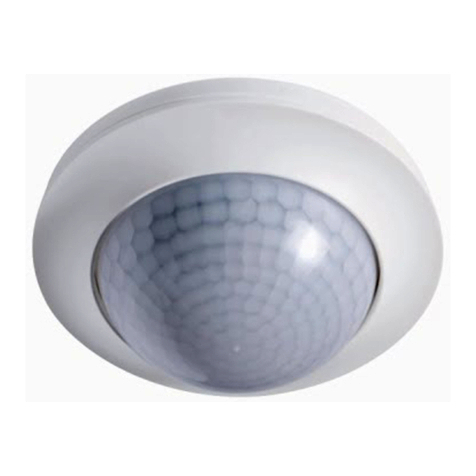
ESYLUX
ESYLUX PD-C360i/24 DUOplus-FM manual
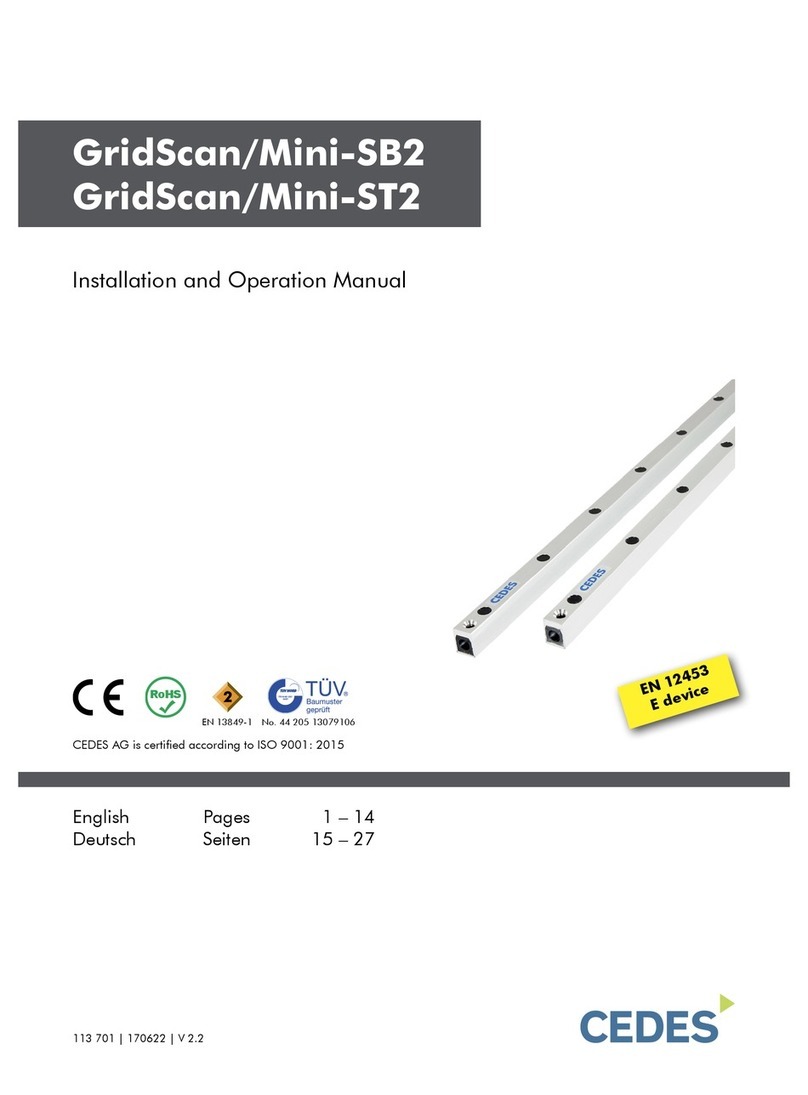
Cedes
Cedes GridScan/Mini-SB2 Installation and operation manual
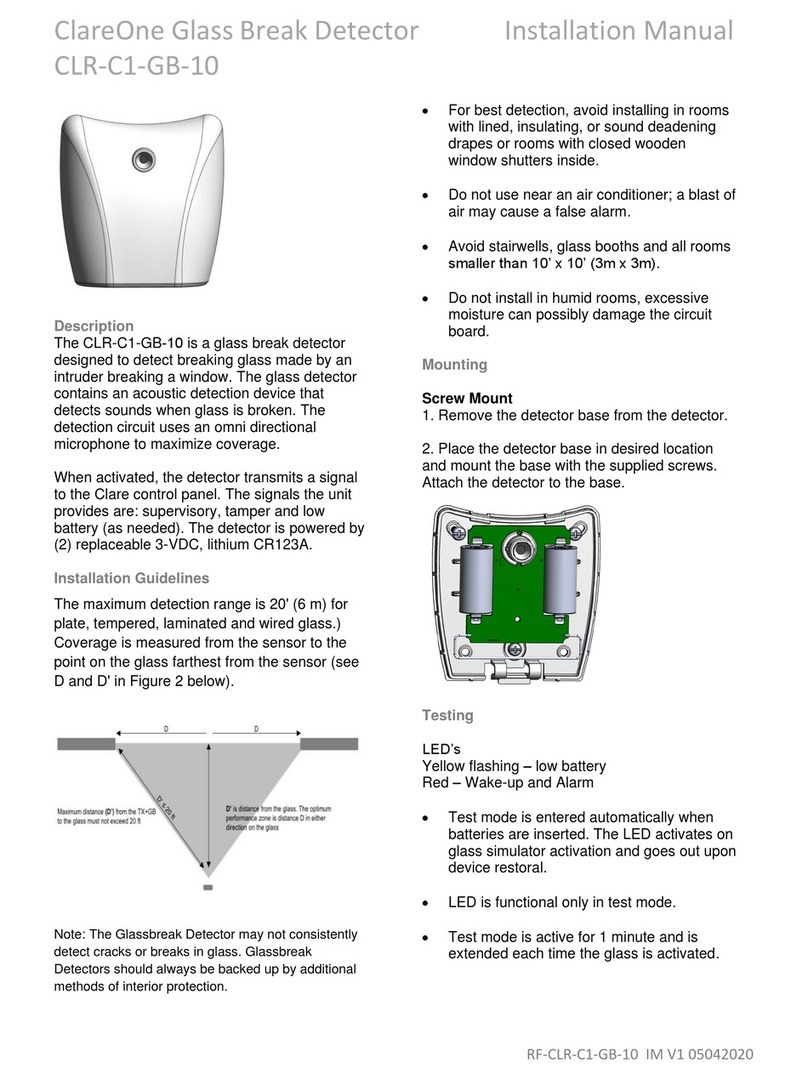
ClareOne
ClareOne CLR-C1-GB-10 installation manual

Lowenstein Medical
Lowenstein Medical JOYCE SilkGel Instructions for use
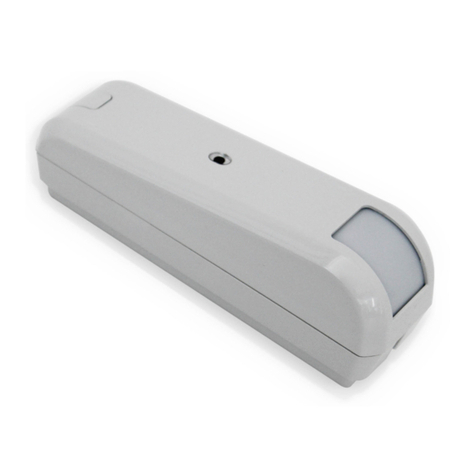
Ksenia
Ksenia velum DT AM installation guide
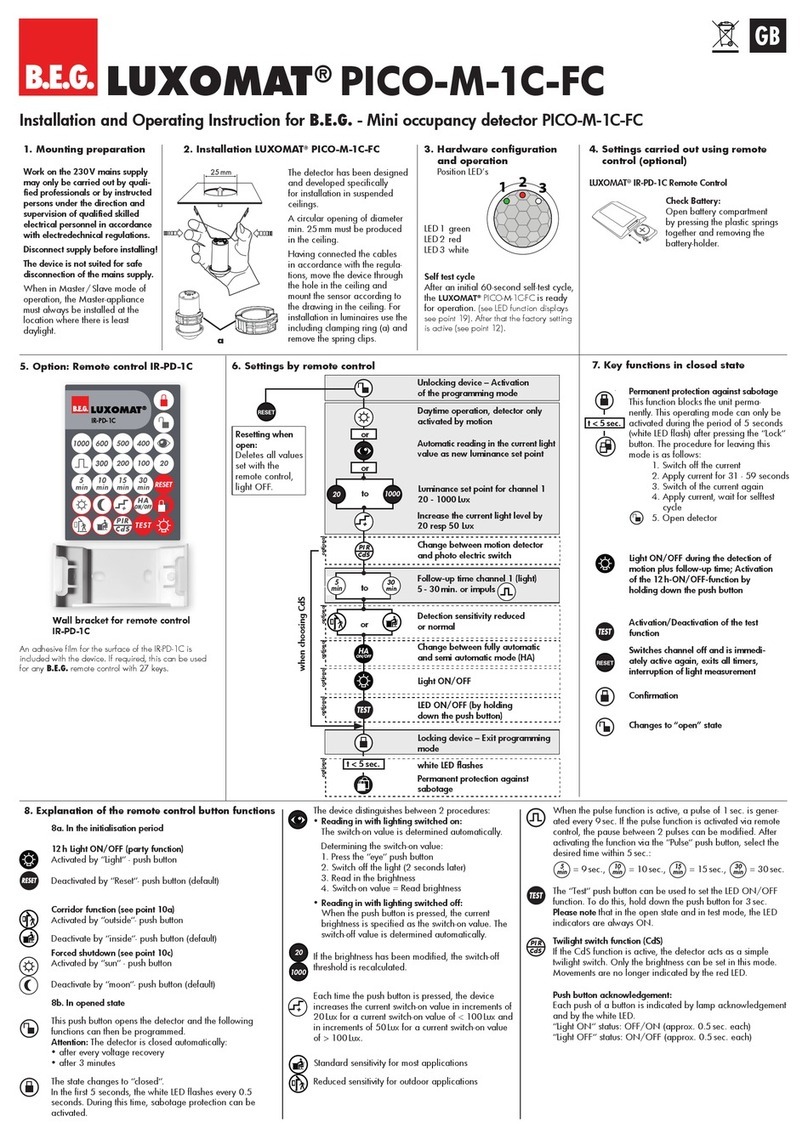
B.E.G.
B.E.G. Luxomat PICO-M-1C-FC Installation and operating instruction

